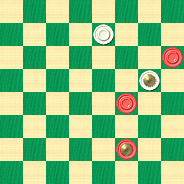The Checker Maven
Jump to navigationWhat Is A Gem?

The definition of a 'gem' problem in checkers is not always clear. We like to think of this in a manner that extends the metaphor: a problem or situation that sparkles and is brilliant in its solution.
Today's installment of our Checker School series presents Dunne's Gem as published in Ben Boland's Famous Positions in the Game of Checkers. Here's the situation:

BLACK
Black to Play and Win
B:W26,K17:B21,14,K6.
Now, Black is a man up. What's so special, so gem-like, about this position (if, indeed, anything)?
Work out the solution and then you decide. Is this a true gem or just an ordinary lump of coal? As you might expect there is more here than meets the eye at first glance.
When you're ready, click on Read More for the solution, a sample game, and some notes, quotes, and votes.![]()
Solution
6-10, 17-22, 21-25---i, 22-29, 14-18, 29-25, 10-15, 25-21, 15-19, 21-25, 19-24, 26-22, 24-19---ii. Black Wins.
Game: 10-15, 24-19, 15-24, 28-19, 9-14, 22-18, 5-9, 18-15, 11-18, 21-17, 14-21, 23-5, 8-11, 25-22, 7-10, 22-18, 4-8, 27-23, 2-7, 32-28, 11-16, 29-25, 8-11, 25-22, 16-20, 28-24, 20-27, 31-24, 6-9, 22-17, 11-16, 17-13, 16-20, 13-6, 20-27, 19-16, 12-19, 23-16, 7-11, 16-7, 27-31, 26-22, 31-27, 7-2, 27-23, 2-7, 23-14, 7-11, 14-9, 6-2, 10-14, 22-17, 14-18, 17-14, 18-23, 14-10, 23-27, 11-15, 27-31, 15-19, 31-27, 10-6, 1-10, 5-1, 9-5, 1-6, 10-14, 19-23, 27-18, 2-7, 3-10, 6-22, 5-1, 30-26, 1-6, 2-17. Forms above position. Geo. Crookston, Game No. 1751 Aberdeen Citizen, Oct. 14, 1921.
This note was given in the Aberdeen Citizen: "Runs into problem No. 257 in Gould's Problem Book by the late Frank Dunne who got the ending from a single corner game."
"We are not aware if the play leading up to the position was ever published. If so it seems to be lost in obscurity as the position was first published in 1873. The play leading up to it may be found in some draughts periodical of those far off times.---iii"
"The present is the only occasion that we have come across it in actual play."
Dunne's Gem may be found as No. 91 in Lyman's and No. 257 in Gould's Problem Book, but probably first published in the "Recreationist." Usually the king on 6 is on 15, but the play is the same.
Editor's Notes
i---10-15 also wins: 26-23---iv 15-10 23-19 10-7 19-16 7-10 16-11 10-15 11-7 14-18 22-17 (22-26 21-25) 18-23 etc. Black Wins.
ii---After 22-15 19-10 Black has the opposition or "the move" and wins.
iii---The newpaper editor of 1921 refers to 1873 as "those far-off times." How far-off 1921 seems to us now in 2006! And yet, a position that is over 130 years old can still interest us today. What a testimony to the timelessness of our game of checkers!
iv---Alert reader Jim Dobie notes that if White plays 22-17 instead, Black has to play 15-10 (not 14-18 17-14), returning to the "gem" solution line. Black does not have to try to play the gem line to win, but White can force it!
It's a very clever win with the pitch of the extra man and a speedy resolution of the situation; that's indeed gem-like. But as our notes show, Black can win without the pitch, with more-or-less straightforward play which takes advantage of his extra man. The win would be many, many moves longer, but it is still there; solid and workmanlike, but certainly not a gem of an answer.
However, as reader Jim Dobie points out, if White doesn't want to prolong the game, the gem solution can be forced--- by White!
So, in the final analysis, is Dunne's Gem a true sparkler? While the traditional solution surely shines, there are alternative paths to a long, drawn-out win. We like the "gem" solution the best!
Tell us what you think by writing to us at webmaster@checkermaven.com.
You can email the Webmaster with comments on this article.
